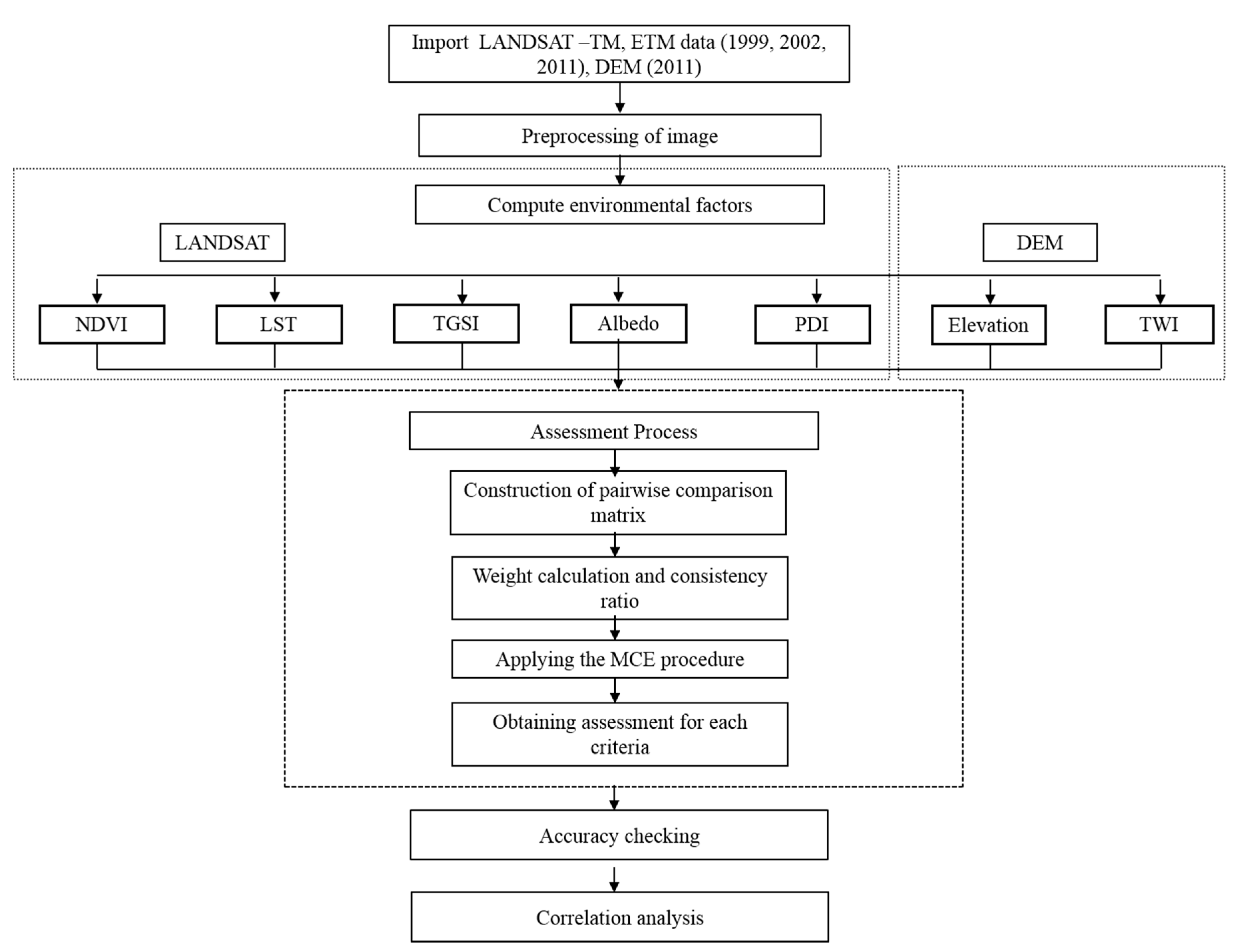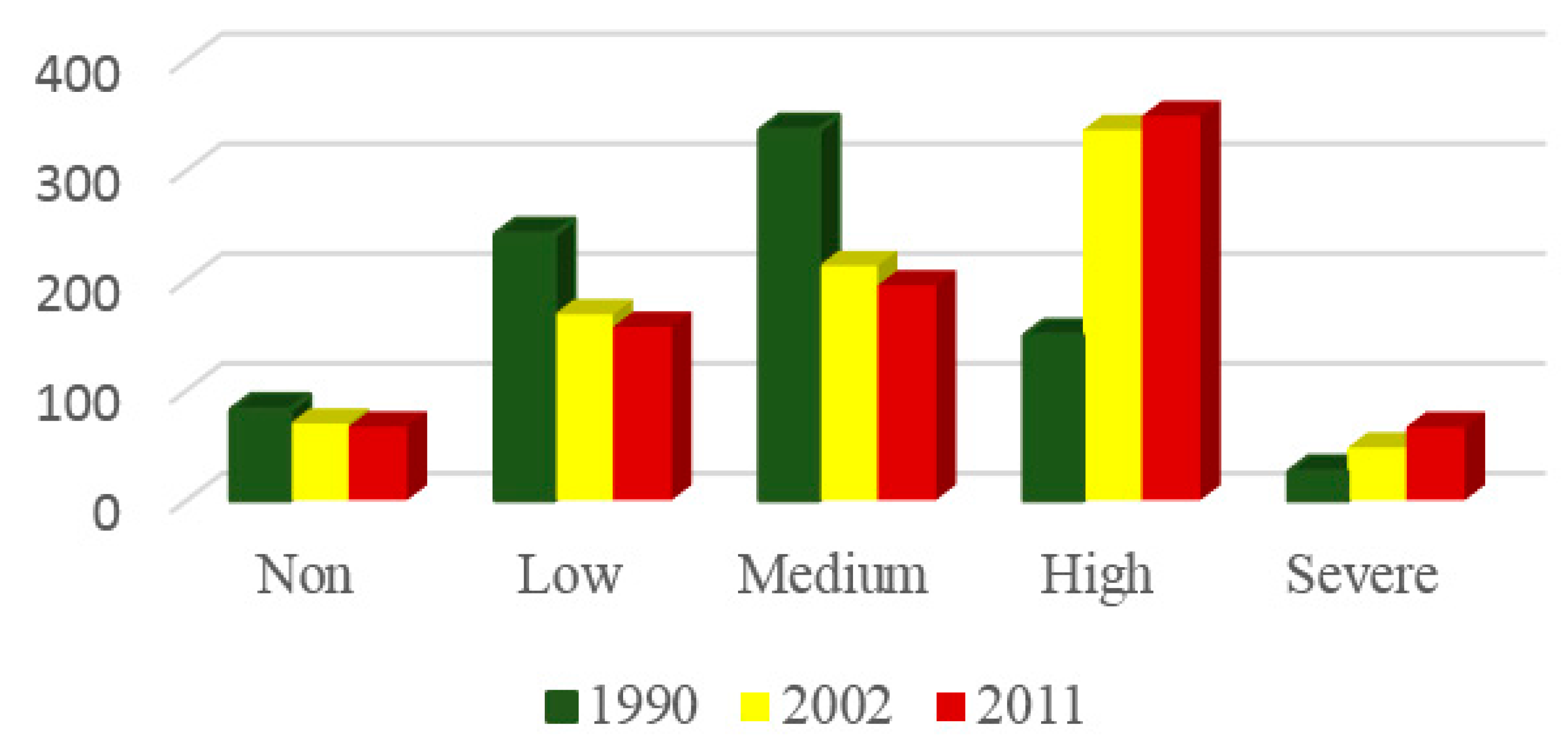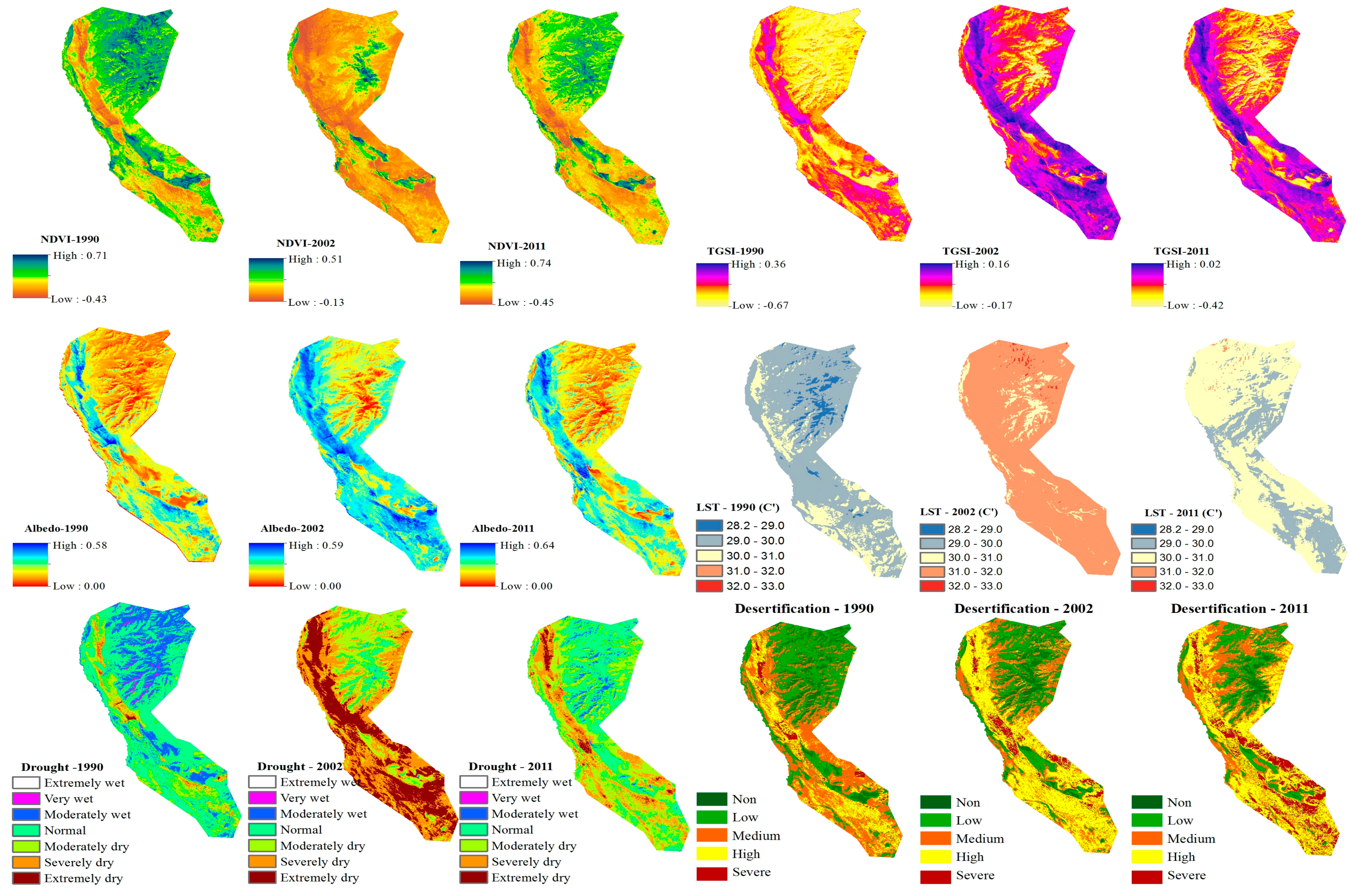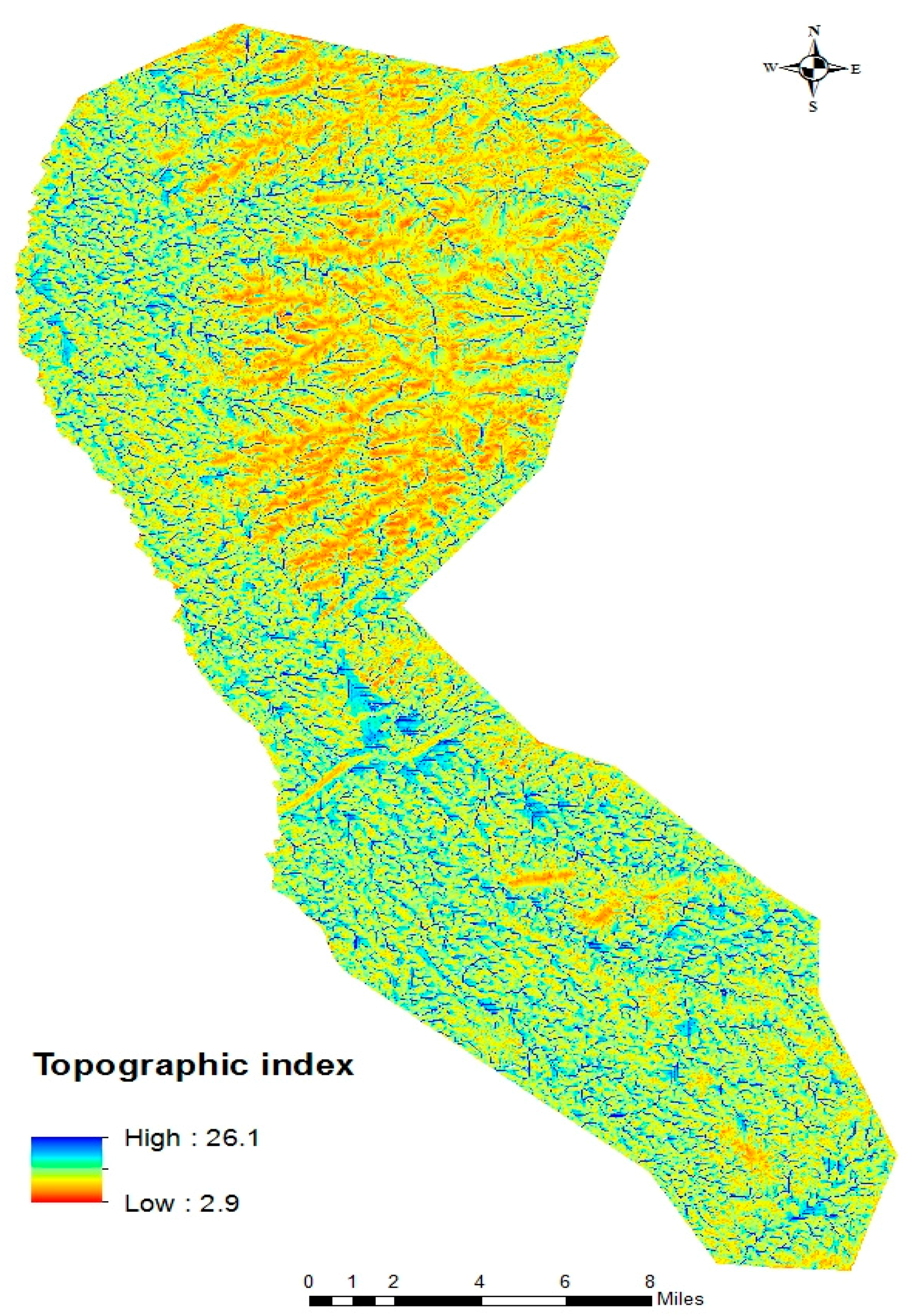Correlation between Desertification and Environmental Variables Using Remote Sensing Techniques in Hogno Khaan, Mongolia
Abstract
:1. Introduction
2. Study Area
3. Materials and Methods
3.1. Materials and Preprocessing
3.2. Processing of Images
Environmental Variables
3.3. Assessment Method
3.3.1. Weights and Scores
3.3.2. Desertification Assessment Map
- = Desertification map,
- = weight of each information layer,
- = map of each information layer.
3.4. Accuracy Checking
3.5. Linear Correlation Analysis
4. Results and Discussion
4.1. Assessment of Desertification, Distribution of Environmental Variables
4.2. DeserTification Accuracy Checking
4.3. Linear Correlation between Desertification Level and Environmental Variables
5. Conclusions
Acknowledgments
Author Contributions
Conflicts of Interest
References
- UNCCD (United Nations Convention to Combat Desertification). United Nations Convention to Combat Desertification in Those Countries Experiencing Serious Drought and/or Desertification, Particularly in Africa; UN: Paris, France, 1994. [Google Scholar]
- UNCCD (United Nations Convention to Combat Desertification). Recommendations and Conclusions of the African Regional Conference Preparatory to the First Session of the Committee for the Review of the Implementation of the United Nations Convention to Combat Desertification (UNCCD–CRIC1); Secretariat of the Convention to Combat Desertification: Windhoek, Namibia, 2002. [Google Scholar]
- Kosmas, C.; Kirkby, M.J.; Geeson, N. Manual on Key Indicators of Desertification and Mapping Environmentally Sensitive Areas to Desertification. Available online: https://www.kcl.ac.uk/projects/desertlinks/downloads/publicdownloads/ESA%20Manual.pdf (accessed on 16 December 2013).
- Brandt, J.; Geeson, N.; Imeson, A. A Desertification Indicator System for Mediterranean Europe. Available online: http://www.kcl.ac.uk/projects/desertlinks/downloads/publicdownloads/Towards%20a%20DISME.zip (accessed on 16 December 2013).
- Geeson, N.; Brandt, J. State of the art on existing indicators and their use for desertification monitoring and CCD implementation in the northern Mediterranean. In AIDCCD e Active Exchange of Experience on Indicators and Development of Perspectives in the Context of UNCCD; Nucleo Ricerca Desertificazione, University of Sassari: Sassari, Italy, 2005; p. 28. [Google Scholar]
- Baartman, J.E.M.; van Lynden, G.W.J.; Reed, M.S.; Ritsema, C.J.; Hessel, R. Desertification and Land Degradation: Origins, Processes, and Solutions—A Literature Review (Series: Scientific Reports. Report Number 4); ISRIC—World Soil Information: Wageningen, The Netherlands, 2007. [Google Scholar]
- Sommer, S.; Zucca, C.; Grainger, A.; Cherlet, M.; Zougmore, R.; Sokona, Y.; Hill, J.; Della Peruta, R.; Roehrig, J.; Wang, G. Application of indicator systems for monitoring and assessment of desertification from national to global scales. Land Degrad. Dev. 2011, 22, 184–197. [Google Scholar] [CrossRef]
- Dregne, H.; Kassas, M.; Rozanov, B. A new assessment of the world status of desertification. Desertification Control Bull. 1991, 20, 6–18. [Google Scholar]
- Kassas, M. Desertification: A general review. J. Arid Environ. 1995, 30, 115–128. [Google Scholar] [CrossRef]
- Sivakumar, M.V.K. Interactions between climate and desertification. Agric. For. Meteorol. 2007, 142, 143–155. [Google Scholar] [CrossRef]
- Arnalds, A. Desertification in a humid environment: An example from Iceland. In Encyclopedia of Soil Science, 2nd ed.; Lal, R., Ed.; Taylor & Francis: Boca Raton, FL, USA, 2006; p. 6. [Google Scholar]
- Liu, Y.; Gao, J.; Yang, Y. A holistic approach towards assessment of severity of land degradation along the Great Wall in northern Shaanxi province, China. Environ. Monit. Assess. 2003, 82, 187–202. [Google Scholar] [CrossRef] [PubMed]
- Geist, H.J.; Lambin, E.F. Dynamic causal patterns of desertification. Bioscience 2004, 54, 817–829. [Google Scholar] [CrossRef]
- Liu, S.L.; Wang, T. Aeolian desertification from the mid-1970s to 2005 in Otindag Sandy Land, Northern China. Environ. Geol. 2007, 51, 1057–1064. [Google Scholar] [CrossRef]
- Shalaby, A.; Tateishi, R. Remote sensing and GIS for mapping and monitoring land cover and land-use changes in the Northwestern coastal zone of Egypt. Appl. Geogr. 2007, 27, 28–41. [Google Scholar] [CrossRef]
- Zhang, Y.Z.; Chen, Z.Y.; Zhu, B.Q.; Luo, X.Y.; Guan, Y.N.; Guo, S.; Nie, Y.P. Land desertification monitoring and assessment in Yulin of Northwest China using remote sensing and geographic information systems (GIS). Environ. Monit. Assess. 2008, 147, 327–337. [Google Scholar] [CrossRef] [PubMed]
- Hu, G.Y.; Dong, Z.B.; Lu, J.F.; Yan, C.Z. Driving forces responsible for aeolian desertification in the source region of the Yangtze River from 1975 to 2005. Environ. Earth Sci. 2012, 66, 257–263. [Google Scholar] [CrossRef]
- Li, J.Y.; Yang, X.C.; Jin, Y.X.; Yang, Z.; Huang, W.G.; Zhao, L.N.; Gao, T.; Yu, H.D.; Ma, H.L.; Qin, Z.H.; et al. Monitoring and analysis of grassland desertification dynamics using Landsat images in Ningxia, China. Remote Sens. Environ. 2013, 138, 19–26. [Google Scholar] [CrossRef]
- Xue, Z.J.; Qin, Z.D.; Li, H.J.; Ding, G.W.; Meng, X.W. Evaluation of aeolian desertification from 1975 to 2010 and its causes in northwest Shanxi Province, China. Glob. Planet Chang. 2013, 107, 102–108. [Google Scholar] [CrossRef]
- Salvati, L.; Zitti, M.; Ceccarelli, T. Integrating economic and environmental indicators in the assessment of desertification risk: A case study. Appl. Ecol. Environ. Res. 2008, 6, 129–138. [Google Scholar] [CrossRef]
- Ding, H.; Chen, J.; Wang, G. A model for desertification evolution employing GIS with cellular automata. In Proceedings of the International Conference on Computer Modeling and Simulation, Macau, China, 20–22 February 2009; pp. 324–328. [Google Scholar]
- Wang, T.; Wu, W.; Wang, X.Z. Remote sensing monitoring and assessing sandy desertification: An example from the sandy desertification region of northern China. Quat. Sci. 1998, 2, 108–118. (In Chinese) [Google Scholar]
- Prince, S.D. Spatial and temporal scales for detection of desertification. In Global Desertification: Do Humans Cause Deserts? Reynolds, J.F., Stafford Smith, D.M., Eds.; Dahlem University Press: Berlin, Germany, 2002; pp. 23–41. [Google Scholar]
- Asner, G.P.; Heidebrecht, K.B. Desertification alters regional ecosystem—Climate interactions. Glob. Chang. Biol. 2005, 11, 182–194. [Google Scholar] [CrossRef]
- Veron, S.R.; Paruelo, J.M.; Oesterheld, M. Assessing desertification. J. Arid Environ. 2006, 66, 751–763. [Google Scholar] [CrossRef]
- Hanafi, A.; Jauffret, S. Are long-term vegetation dynamics useful in monitoring and assessing desertification processes in the arid steppe, southern Tunisia. J. Arid Environ. 2008, 72, 557–572. [Google Scholar] [CrossRef]
- Holm, A.M.; Cridland, S.W.; Roderick, M.L. The use of time-integrated NOAA NDVI data and rainfall to assess landscape degradation in the arid shrubland of Western Australia. Remote Sens. Environ. 2003, 85, 145–158. [Google Scholar] [CrossRef]
- Evans, J.; Geerken, R. Discrimination between climate and human-induced dryland degradation. J. Arid Environ. 2004, 57, 535–554. [Google Scholar] [CrossRef]
- Geerken, R.; Ilaiwi, M. Assessment of rangeland degradation and development of a strategy for rehabilitation. Remote Sens. Environ. 2004, 90, 490–504. [Google Scholar] [CrossRef]
- Wessels, K.J.; Prince, S.D.; Frost, P.E.; Van Zyl, D. Assessing the effects of human-induced land degradation in the former homelands of northern South Africa with a 1 km AVHRR NDVI time-series. Remote Sens. Environ. 2004, 91, 47–67. [Google Scholar] [CrossRef]
- Herrmann, S.M.; Anyamba, A.; Tucker, C.J. Recent trends in vegetation dynamics in the African Sahel and their relationship to climate. Glob. Environ. Chang. 2005, 15, 394–404. [Google Scholar] [CrossRef]
- Wessels, K.J.; Prince, S.D.; Malherbe, J.; Small, J.; Frost, P.E.; Van Zyl, D. Can human-induced land degradation be distinguished from the effects of rainfall variability? A case study in South Africa. J. Arid Environ. 2007, 68, 271–297. [Google Scholar]
- Xu, D.; Kang, X.; Qiu, D.; Zhuang, D.; Pan, J. Quantitative assessment of desertification using Landsat data on a regional scale—A case study in the Ordos Plateau, China. Sensors 2009, 9, 1738–1753. [Google Scholar] [CrossRef] [PubMed]
- Lamchin, M.; Lee, Y.L.; Lee, W.K.; Lee, E.J.; Kim, M.; Lim, C.H.; Choi, H.A.; Kim, S.R. Assessment of land cover change and desertification using remote sensing technology in a local of Mongolia. Adv. Space Res. 2016, 57, 64–77. [Google Scholar] [CrossRef]
- Xiao, J.; Shen, Y.; Tateishi, R.; Bayaer, W. Development of topsoil grain size index for monitoring desertification in arid land using remote sensing. Int. J. Remote Sens. 2006, 27, 2411–2422. [Google Scholar] [CrossRef]
- Jackson, R.D.; Idso, S.B.; Otterman, J. Surface albedo and desertification. Science 1975, 189, 1012–1015. [Google Scholar] [CrossRef] [PubMed]
- Li, S.G.; Harazono, Y.; Oikawa, T.; Zhao, H.L.; He, Z.Y.; Chang, X.L. Grassland desertification by grazing and the resulting micrometeorological changes in Inner Mongolia. Agr. For. Meteorol. 2000, 102, 125–137. [Google Scholar]
- Riobinove, C.J.; Chavez, P.S.; Gehring, D.; Holmgren, R. Arid land monitoring using Landsat albedo difference images. Remote Sens. Environ. 1981, 11, 133–156. [Google Scholar] [CrossRef]
- Chavez, P.S., Jr. An improved dark-object subtraction technique for atmospheric scattering correction of multispectral data. Remote Sens. Environ. 1988, 24, 459–479. [Google Scholar] [CrossRef]
- Chavez, P.S., Jr. Image-based atmospheric corrections—Revisited and improved. Photogramm. Eng. Remote Sens. 1996, 62, 1025–1036. [Google Scholar]
- Musick, H.B. Temporal change of Landsat MSS albedo estimates in arid rangeland. Remote Sens. Environ. 1986, 20, 107–120. [Google Scholar] [CrossRef]
- Liang, S.L. Narrowband to broadband conversions of land surface albedo algorithms. Remote Sens. Environ. 2000, 76, 213–238. [Google Scholar] [CrossRef]
- Smith, R.B. The Heat Budget of the Earth’s Surface Deduced from Space. 2010. Available online: http://yceo.yale.edu/sites/default/files/files/Surface_Heat_Budget_From_Space.pdf (accessed on 10 April 2017).
- Ghulam, A.; Qin, Q.; Zhan, Z. Designing of the perpendicular drought index. Environ. Geol. 2007, 52, 1045–1052. [Google Scholar] [CrossRef]
- Gessler, P.E.; Moore, I.D.; McKenzie, N.J.; Ryan, P.J. Soil-landscape modeling and spatial prediction of soil attributes. Int. J. Geogr. Inf. Syst. 1995, 9, 421–432. [Google Scholar] [CrossRef]
- Moore, I.D.; Gessler, P.E.; Nielsen, G.A.; Peterson, G.A. Soil attribute prediction using terrain analysis. Soil Sci. Soc. Am. J. 1993, 57, 443–452. [Google Scholar] [CrossRef]
- Arvidson, T.; Landsat Project Science Office, Goddard Space Flight Center, Washington, DC, USA. Personal communication, 2002.
- Landsat Project Science Office. Landsat 7 Science Data User’s Handbook. Available online: https://landsat.gsfc.nasa.gov/wp-content/uploads/2016/08/Landsat7_Handbook.pdf (accessed on 10 April 2017).
- Saaty, T.L. A scaling method for priorities in hierarchical structures. J. Math. Physiol. 1977, 15, 234–281. [Google Scholar] [CrossRef]
- Hossain, M.S.; Rahman, M.F.; Thompson, S.; Nabi, M.R.; Kibria, M.M. Climate change resilience assessment using livelihood assets of coastal fishing community in Nijhum Dwip, Bangladesh. Sci. Technol. 2013, 21, 397–422. [Google Scholar]
- Hossain, M.S.; Das, N.G. GIS-based multi-criteria evaluation to land suitability modelling for giant prawn (Macrobrachium rosenbergii) farming in Companigonj Upazila of Noakhali, Bangladesh. Comput. Electron. Agr. 2010, 70, 172–186. [Google Scholar] [CrossRef]
- Eastman, J.R.; Kyem, P.A.K.; Toledano, J.; Jin, W. United Nations Institute for Training and Research, Explorations in Geographic Information Systems Technology; The Clarks Labs for Cartographic Technology and Geographic Analysis, Clark University: Worcester, MA, USA, 1993. [Google Scholar]
- Wang, X.D.; Zhong, X.H.; Liu, J.G.; Wang, Z.Y.; Li, M.H. Regional assessment of environmental vulnerability in the Tibetan Plateau. J. Arid Environ. 2008, 72, 1929–1939. [Google Scholar] [CrossRef]
- Liu, C.; Frazier, P.; Kumar, L. Comparative assessment of the measures of thematic classification accuracy. Remote Sens. Environ. 2007, 107, 606–616. [Google Scholar] [CrossRef]
- Stehman, S.V. Selecting and interpreting measures of thematic classification accuracy. Remote Sens. Environ. 1997, 62, 77–89. [Google Scholar] [CrossRef]
- Foody, G.M. Status of land covers classification accuracy assessment. Remote Sens. Environ. 2002, 80, 185–201. [Google Scholar] [CrossRef]
- Pontius, R.G.; Millones, M. Death to kappa: Birth of quantity disagreement and allocation disagreement for accuracy assessment. Int. J. Remote Sens. 2011, 32, 4407–4429. [Google Scholar] [CrossRef]
- Tian, F.; Qiu, G.Y.; Yang, Y.H.; Xiong, Y.J.; Wang, P. Studies on the relationships between land surface temperature and environmental factors in an inland river catchment-based on geographically weighted regression and MODIS data. IEEE J. Sel. Top. Appl. 2012, 5, 687–698. [Google Scholar] [CrossRef]
- Goetz, S.J. Multi-sensor analysis of NDVI surfaces temperature and biophysical variables at a mixed grassland site. Int. J. Remote Sens. 1997, 18, 71–94. [Google Scholar] [CrossRef]
- Kustas, W.P.; Moran, M.S.; Humes, K.S.; Stannard, D.L.; Pinter, P.; Hipps, L.E.; Swiatek, E.; Goodrich, D.C. Surface energy balance estimates at local and regional scales using optical remote sensing and atmospheric data collected over semiarid rangelands. Water Resour. Res. 1994, 30, 1241–1259. [Google Scholar] [CrossRef]
- Sandholt, I.; Rasmussen, K.; Andersen, J. A simple interpretation of the surface temperature/vegetation index space for assessment of surface moisture status. Remote Sens. Environ. 2002, 79, 213–224. [Google Scholar] [CrossRef]
- Shi, Y.; Shen, Y.; Kang, E.; Li, D.; Ding, Y.; Zhang, G.; Hu, R. Recent and future climate change in Northwest China. Clim. Chang. 2007, 80, 379–393. [Google Scholar] [CrossRef]
- Qian, W.; Lin, X. Regional trends in recent precipitation indices in China Meteorol. Atmos. Phys. 2005, 90, 193–207. [Google Scholar] [CrossRef]
- Retzer, V.; Nadrowski, K.; Miehe, G. Variation of precipitation and its effect on phytomass production and consumption by livestock and large wild herbivores along an altitudinal gradient during a drought, South Gobi, Mongolia. J. Arid Environ. 2006, 66, 135–150. [Google Scholar] [CrossRef]




| 1/9 | 1/8 | 1/7 | 1/6 | 1/5 | 1/4 | 1/3 | 1/2 | 1 | 2 | 3 | 4 | 5 | 6 | 7 | 8 | 9 | |
|---|---|---|---|---|---|---|---|---|---|---|---|---|---|---|---|---|---|
| Extremely | Very strongly | Strongly | Moderately | Equally | Moderately | Strongly | Very strongly | Extremely | |||||||||
| Less Important | More Important | ||||||||||||||||
| Assets | ||||||||
|---|---|---|---|---|---|---|---|---|
| NDVI | LST | TGSI | Albedo | Elevation | PDI | TWI | Weight | |
| NDVI | 1 | 1/2 | 2 | 4/5 | 1/1 | 2/5 | 1/5 | 0.1032 |
| LST | 5 | 1 | 1/5 | 1/2 | 1/2 | 3 | 1/2 | 0.3688 |
| TGSI | 6 | 1/2 | 1 | 2 | 1/1 | 2 | 1/2 | 0.0704 |
| Albedo | 1/5 | 1/2 | 1/2 | 1 | 1/1 | 1/5 | 1/2 | 0.0387 |
| Elevation | 3 | 3/5 | 2/5 | 1/5 | 1 | 1/5 | 3 | 0.0758 |
| PDI | 5 | 5 | 1/2 | 2/2 | 1/1 | 1 | 1/2 | 0.2197 |
| TWI | 2/5 | 2 | 2 | 2 | 2 | 1/2 | 1 | 0.1234 |
| Consistency ratio (CR): 0.0044 | ||||||||
| Variables | 1990 | 2002 | 2011 |
|---|---|---|---|
| NDVI | 0.71 | 0.51 | 0.74 |
| Albedo | 0.59 | 0.69 | 0.64 |
| TGSI | 0.36 | 0.16 | 0.02 |
| LST | 30.6 | 32.2 | 31.2 |
| PDI | 0.36 | 0.79 | 0.64 |
| Correlation | Non | Low | Medium | High | Severe |
|---|---|---|---|---|---|
| 1990 | |||||
| NDVI and TGSI | −0.20 | −0.38 | −0.38 | −0.57 | −0.28 |
| NDVI and Albedo | −0.06 | −0.21 | −0.34 | −0.58 | −0.34 |
| Albedo and TGSI | 0.77 | 0.72 | 0.45 | 0.69 | 0.33 |
| NDVI and LST | 0.29 | −0.61 | −0.04 | −0.03 | 0.10 |
| NDVI and PDI | 0.83 | 0.49 | 0.15 | −0.66 | −0.66 |
| PDI and TGSI | 0.55 | 0.40 | 0.52 | 0.87 | 0.87 |
| LST and TGSI | 0.22 | 0.31 | 0.24 | 0.11 | −0.07 |
| Elevation and NDVI | −0.25 | −0.08 | 0.07 | 0.09 | 0.24 |
| Albedo and PDI | −0.10 | 0.71 | 0.12 | 0.97 | 0.50 |
| Albedo and LST | 0.15 | 0.37 | 0.18 | 0.05 | −0.04 |
| PDI and LST | 0.56 | 0.25 | −0.08 | 0.05 | −0.13 |
| TWI and NDVI | 0.32 | 0.19 | 0.05 | −0.01 | −0.04 |
| TWI and PDI | 0.34 | 0.15 | −0.03 | −0.03 | −0.00 |
| 2002 | |||||
| NDVI and TGSI | −0.53 | −0.30 | −0.25 | −0.17 | −1.00 |
| NDVI and Albedo | −0.39 | −0.57 | −0.30 | −0.46 | −0.46 |
| Albedo and GSI | 0.92 | 0.73 | 0.48 | 0.57 | 0.07 |
| NDVI and LST | −0.22 | −0.26 | −0.18 | −0.09 | −0.02 |
| NDVI and PDI | 0.33 | 0.58 | −0.00 | −0.34 | −0.38 |
| PDI and TGSI | 0.58 | 0.39 | 0.56 | 0.85 | 0.81 |
| LST and TGSI | 0.47 | 0.27 | 0.10 | −0.03 | 0.04 |
| Elevation and NDVI | 0.02 | −0.26 | 0.26 | 0.49 | 0.55 |
| Albedo and PDI | 0.80 | 0.83 | 0.95 | 0.96 | 0.98 |
| Albedo and LST | 0.45 | 0.15 | 0.00 | 0.02 | −0.04 |
| PDI and LST | 0.30 | 0.00 | −0.01 | 0.02 | −0.02 |
| TWI and NDVI | 0.38 | 0.35 | 0.04 | −0.00 | −0.04 |
| TWI and PDI | 0.36 | 0.30 | 0.10 | 0.00 | −0.00 |
| 2011 | |||||
| NDVI and TGSI | −0.34 | −0.51 | −0.37 | −0.41 | −0.36 |
| NDVI and Albedo | −0.12 | −0.20 | −0.25 | −0.30 | −0.31 |
| Albedo and TGSI | 0.80 | 0.70 | 0.39 | 0.38 | 0.33 |
| NDVI and LST | 0.08 | −0.04 | 0.05 | −0.02 | −0.14 |
| NDVI and PDI | 0.75 | 0.56 | −0.04 | −0.39 | −0.54 |
| PDI and TGSI | 0.35 | 0.25 | 0.52 | 0.73 | 0.84 |
| LST and TGSI | 0.45 | 0.16 | 0.03 | 0.16 | 0.33 |
| Elevation and NDVI | −0.17 | −0.10 | 0.12 | 0.27 | 0.33 |
| Albedo and PDI | −0.01 | 0.16 | 0.33 | 0.48 | 0.64 |
| Albedo and LST | 0.09 | 0.02 | 0.07 | 0.26 | 0.44 |
| PDI and LST | 0.39 | 0.07 | 0.11 | 0.42 | 0.55 |
| TWI and NDVI | 0.34 | 0.22 | 0.08 | −0.04 | −0.01 |
| TWI and PDI | 0.35 | 0.23 | 0.03 | 0.01 | −0.01 |
| Desertification | 1990 | |||||||
| Grade | No | Low | Medium | High | Severe | Total | Producer Accuracy | User Accuracy |
| No | 87 | 18 | 2 | 0 | 0 | 107 | 92.07% | 86.91% |
| Low | 14 | 88 | 10 | 0 | 0 | 112 | 77.39% | 79.46% |
| Medium | 0 | 9 | 89 | 4 | 0 | 102 | 80.58% | 81.37% |
| High | 0 | 0 | 2 | 85 | 24 | 111 | 94.05% | 85.58% |
| Severe | 0 | 0 | 0 | 12 | 82 | 94 | 87.73% | 98.93% |
| Total | 101 | 115 | 103 | 101 | 106 | 526 | ||
| Overall accuracy 0.86, kappa statistic 0.77. | ||||||||
| Desertification | 2002 | |||||||
| Grade | No | Low | Medium | High | Severe | Total | Producer Accuracy | User Accuracy |
| Non | 93 | 12 | 1 | 0 | 0 | 107 | 86.13% | 81.30% |
| Low | 8 | 89 | 15 | 0 | 0 | 112 | 76.51% | 78.57% |
| Medium | 0 | 14 | 83 | 5 | 0 | 102 | 86.40% | 87.25% |
| High | 0 | 0 | 4 | 95 | 13 | 111 | 84.15% | 76.57% |
| Severe | 0 | 0 | 0 | 1 | 93 | 94 | 73.35% | 87.23% |
| Total | 101 | 115 | 103 | 101 | 106 | 526 | ||
| Overall accuracy 0.81, kappa statistic 0.82. | ||||||||
| Desertification | 2011 | |||||||
| Grade | No | Low | Medium | High | Severe | Total | Producer Accuracy | User Accuracy |
| No | 92 | 9 | 6 | 0 | 0 | 107 | 91.08% | 85.98% |
| Low | 9 | 91 | 11 | 1 | 0 | 112 | 79.13% | 81.25% |
| Medium | 0 | 12 | 82 | 6 | 2 | 102 | 79.61% | 80.39% |
| High | 0 | 3 | 4 | 90 | 14 | 111 | 89.10% | 81.08% |
| Severe | 0 | 0 | 0 | 4 | 90 | 94 | 84.90% | 95.74% |
| Total | 101 | 115 | 103 | 101 | 106 | 526 | ||
| Overall accuracy 0.84, kappa statistic 0.80. | ||||||||
© 2017 by the authors. Licensee MDPI, Basel, Switzerland. This article is an open access article distributed under the terms and conditions of the Creative Commons Attribution (CC BY) license (http://creativecommons.org/licenses/by/4.0/).
Share and Cite
Lamchin, M.; Lee, W.-K.; Jeon, S.W.; Lee, J.-Y.; Song, C.; Piao, D.; Lim, C.H.; Khaulenbek, A.; Navaandorj, I. Correlation between Desertification and Environmental Variables Using Remote Sensing Techniques in Hogno Khaan, Mongolia. Sustainability 2017, 9, 581. https://doi.org/10.3390/su9040581
Lamchin M, Lee W-K, Jeon SW, Lee J-Y, Song C, Piao D, Lim CH, Khaulenbek A, Navaandorj I. Correlation between Desertification and Environmental Variables Using Remote Sensing Techniques in Hogno Khaan, Mongolia. Sustainability. 2017; 9(4):581. https://doi.org/10.3390/su9040581
Chicago/Turabian StyleLamchin, Munkhnasan, Woo-Kyun Lee, Seong Woo Jeon, Jong-Yeol Lee, Cholho Song, Dongfan Piao, Chul Hee Lim, Akhmadi Khaulenbek, and Itgelt Navaandorj. 2017. "Correlation between Desertification and Environmental Variables Using Remote Sensing Techniques in Hogno Khaan, Mongolia" Sustainability 9, no. 4: 581. https://doi.org/10.3390/su9040581
APA StyleLamchin, M., Lee, W.-K., Jeon, S. W., Lee, J.-Y., Song, C., Piao, D., Lim, C. H., Khaulenbek, A., & Navaandorj, I. (2017). Correlation between Desertification and Environmental Variables Using Remote Sensing Techniques in Hogno Khaan, Mongolia. Sustainability, 9(4), 581. https://doi.org/10.3390/su9040581










